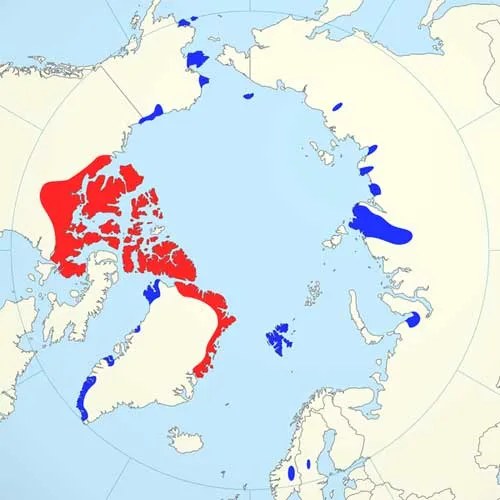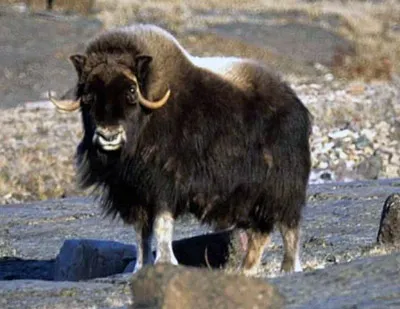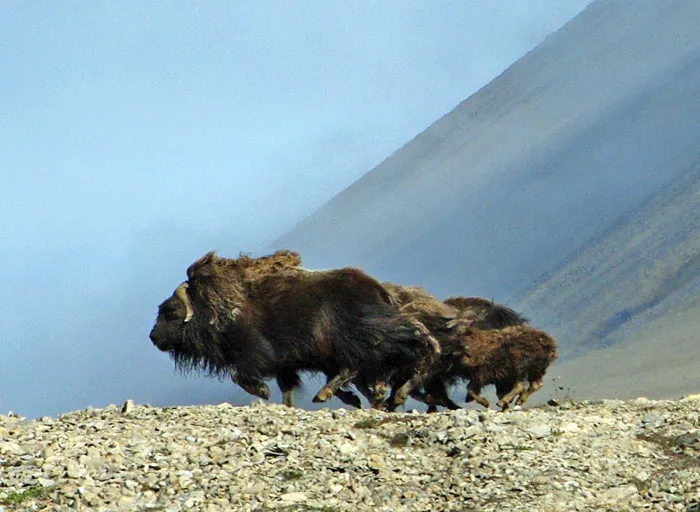Musk Ox - Facts and Adaptations
Ovibos moschatus
Previously widespread across the arctic but wiped out in many places by over-hunting. Musk oxen live in the tundra regions of the high artic, they are grazing animals, more closely related to sheep and goats than to oxen, their Latin name Ovibos means literally "sheep-ox".
Musk ox facts Basics
Picture: A pair of female musk oxen,
the pale patch of hair between the horns shows them to be
female whereas males have a "boss" where the horns join
together.
Average Weight: 180 to
410kg (400 - 900 lbs)
Average Height:
1.1 - 1.5m (4-5 feet) tall at the shoulder, appear to be
larger than they are due to the thick, long coat and large
head. They are smaller than bison which they resemble, bison
can be twice the weight of a musk ox.
Breeding:
Musk oxen are harem breeders in which males compete for
dominance with the winner breeding with all females in oestrus.
Females usually give birth to a single calf every year or
every two or even three years if feeding conditions have
not been favourable. The young are born after an 8 month
pregnancy, twins are uncommon and rarely survive. The young
are very well developed at birth being up and feeding within
around 45 minutes. They are able to follow their mother
back to the herd a few hours later.
Estimated
world population: 150,000 worldwide, of which about
75% are in Canada.
Feeding & diet:
Generalized herbivores eating whatever plant material they
can readily find. In the summer months, this is by preference
soft nutritious grasses and other wild plants. Their faeces
are moist and still high in nutrients at this time indicating
that food is abundant enough that they don't need to try
too hard to absorb all of the nutrition from it. Instead
they can take the easy to get at nutrients and then go for
more food rather than retaining food in the digestive system
for a long time to fully digest it.
In the winter
months, they turn to roots, dwarf willow and dwarf birch,
lichens, mosses and other vegetation they can access beneath
the snow. At this time the faecal matter is dry and has
little nutritional value suggesting a slower process through
the digestive system that leads to a more thorough removal
of nutrients itself a result of less plentiful and less
nutritious food.
Conservation status -
Least Concern.
Distribution:
Arctic North America to Greenland, native to the far north
found in treeless tundra. They were introduced to other
areas around the Arctic during the 20th century where they
had previously died out or been hunted to extinction.
Predators: Arctic wolves are the main
predator and may account for up to 50% of all mortality,
grizzly bears and polar bears are occasional predators,
mainly of calves and infirm adults.
Musk ox = singular
| Musk oxen = plural
 Distribution
range of Musk Oxen. Red - historical natural range, Blue - introduced
populations
Distribution
range of Musk Oxen. Red - historical natural range, Blue - introduced
populations
What are Musk Oxen like? how do they survive?
Musk oxen live in the tundra regions of the high artic, they are grazing animals, more closely related to sheep and goats than to oxen, their Latin name Ovibos means literally "sheep-ox". The name musk ox comes from the strong scent emitted by males in the breeding season, though it is not actually musk.
The species was previously widespread across the arctic but were wiped out in many places by over-hunting. Conservation measures put into place have helped to reverse their decline as have re-introductions especially to places across northern Europe and Asia. Many of the populations are isolated however and are vulnerable to disease and changes in climate. Their main predator is the arctic wolf which hunts them in packs, grizzly and polar bears may take juveniles or infirm older animals.
Musk oxen live in small family and extended groups in the summer of as few as 5 animals, in the winter they may join other animals and form groups of up to 60 individuals. Larger groups help provide protection against predators and also the weather by standing closer.
The musk ox is an animal of the far north. It lives its whole life above the northern tree line in the Arctic tundra. They survive in some of the harshest places in the arctic, they have a number of anatomical, behavioural and physiological adaptations that allow them to do this successfully.


Musk Ox Adaptations:
- Moving seasonally to where the easiest available
foods are found (behavioural) - Musk oxen feed
on grasses and seasonal wild flowers in the spring and summer
months which they often spend in river valleys near to water.
In the colder months, they move onto eating roots mosses
and lichens which they access higher up hillsides to avoid
deep snow. They will dig through ice and snow using their
hooves to reach food, while there may be more of these foods
in the valleys in winter, they are more difficult to access
than on exposed hillsides and at higher elevations where
the snow and ice covering is much thinner.
- Long, thick hair, the most obvious feature of
a musk ox is its long shaggy coat (anatomical)
- which gives them the appearance of being larger and more
powerfully built than they really are. Like many cold climate
mammals their coat consists of long outer guard hairs providing
direct protection against the weather and a shorter inner
coat to give extra insulation. In the case of the musk ox,
this inner coat (called qiviut and prized as one of the
lightest warmest wools available from any animal) grows
in time for the winter months and is shed at the end of
the winter when it starts to get warmer again. The outer
hairs can be as long as 60cm (24 inches).
- Low surface area to volume ratio (anatomical)
- Like many cold climate animals, musk oxen are large. Simply
being large makes it easier to maintain your body temperature
when it is cold as there is relatively less surface area
to lose heat from compared to smaller animals. They also
have short stocky legs and small furry ears, both of which
help to reduce the surface area available for heat loss.
- Hooves (anatomical) - insulate them
from snow and ice. Hooves are made of keratin like fingernail
and hair and so are a dead part of the body without any
blood circulation to lose heat through. Musk oxen have two
weight bearing toes which can spread the weight making for
surer easier footing on soft or slippery surfaces. the hooves
are also used to dig through the snow to reach food.
- Thick layer of body fat (anatomical
/ physiological) - for insulation and food storage to help
survive the winter when food supply may be intermittent.
Laying down a good fat layer in the summer may mean the
difference between surviving the next winter or not.
- When attacked by predators, musk oxen try to run to nearby higher ground and then form a circle with their rumps together and horns facing outwards (behavioral) - The calves stay close to their mothers' sides while the adults take it in turns to rush out to attack the predators with their sharp horns. This is a good strategy against animal predators but not against humans who can take advantage of this tendency to stand their ground to pick the musk oxen off with (historically) bows and spears.

A small family group of musk oxen on Devon Island
in Arctic Canada, typically they are near water in the valley
bottom and feeding on the brief lush growth of seasonal grasses.

Picture use:
Creative Commons Attribution 2.0 license - pair of females - U.S.
Fish and Wildlife Service
Creative Commons Attribution 3.0 license - Distribution map - Gringer
- Masae - derivative work: Retired electrician

